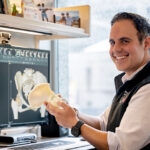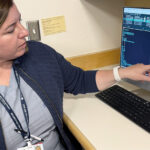Emergency department or urgent clinic? Understanding your options if your child is injured

Having an active or adventurous child often means comforting them when they come home with bumps or bruises. But when an injury is more serious, parents don’t always know where to seek the right level of care. The injury may look serious, but a trip to the emergency department may seem over the top — and can be lengthy and costly.
The Orthopedic Urgent Clinic at Boston Children’s Hospital is a good option for musculoskeletal (bone or muscle) injuries that need to be seen promptly but aren’t serious enough to require emergency care.
Why would a child need urgent orthopedic care?
Children’s orthopedic injuries are different that those in adults and should be treated by specialists who know how to manage pediatric musculoskeletal conditions. An experienced provider can decide on the appropriate care based on your child’s age and stage of physical development.
In many cases, timely treatment can reduce pain and improve a child’s future mobility. “When we recognize injuries early, we can make sure patients have the best treatment and outcome possible,” says orthopedic surgeon Dr. Kristin Livingston, director of Boston Children’s Orthopedic Trauma Program. Most musculoskeletal injuries in children can be managed by immobilizing the injured limb in a sling, brace, or cast, all of which can be accomplished in the Orthopedic Urgent Clinic.
Clinicians in the Orthopedic Urgent Clinic are specialists in diagnosing and treating sprains, ligament tears, and fractures. Patients often receive care on the same day the injury occurs and are followed with multiple visits to ensure their injuries heal properly and completely.
Some injuries, however, require a higher level of care and need to be treated in an emergency department.
What’s the difference between emergency care and orthopedic urgent care?
Signs an injury may require emergency care
- Your child has severe pain or can’t be soothed after their injury
- Their arm or leg is visibly crooked or has severe swelling
- They have an open wound associated with their injury
Emergency departments treat severe injuries and serious illnesses that require immediate attention. For instance, if your child has a deep cut or wound, severe fracture, or if their arm or leg is at an unnatural angle, bring them to an emergency department. Emergency departments can also provide acute pain management for a child who is extremely uncomfortable. For instance, if your child has a fracture that needs to be moved or reset, the emergency department can provide sedation for this type of procedure.
Orthopedic urgent clinics treat less serious injuries in a timely manner. Even injuries that need surgery often don’t need emergency surgery and can be safely assessed in a clinic setting by an orthopedic surgeon. If needed, the Orthopedic Urgent Clinic can perform X-ray and apply a cast or splint to stabilize the injury. Appointments are scheduled in advance, so families don’t have to spend time in an ED waiting area. Care is more affordable than emergency department fees as well.
As long as children are active, there’s a chance they’ll get injured. Knowing where to bring them for care can make a stressful situation more manageable.
Learn about the Orthopedic Urgent Clinic and Orthopedics and Sports Medicine Department.
Related Posts :
-

3D imaging could become standard practice in orthopedics. Here’s how.
It took a trained eye to see the abnormality on the patient’s X-ray. There, hidden behind the acetabulum was ...
-

A safe, pain-specific anesthetic shows preclinical promise
All current local anesthetics block sensory signals — pain — but they also interrupt motor signals, which can be problematic. For example, ...
-

Adam takes a pause from his active life for non-ossifying fibroma
Adam was 11 in early 2024 when he and his bike slid under a downed tree. Such events aren’t unusual for ...
-

Ask a sports medicine specialist: Why are ACL tears so common among female athletes?
When an athlete is sprinting after an opponent who suddenly stops or changes direction, their anterior cruciate ligaments (ACLs) make ...





